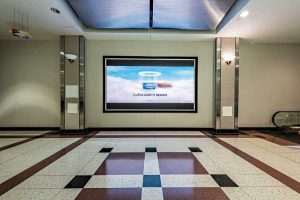
The project included five murals, the stair risers and treads, a digital wall display, and an angelic hum sound file for the stairs to play at rising pitches.
The three wall murals measured 5.6 x 2 m (18.5 x 6.8 ft), 3.3 x 2.2 m (11 x 7.4 ft), and 11.4 x 4.7 m (37.5 x 15.5 ft). They were produced on Drytac Polar Premium vinyl with a matte interlam lamination. The 6.5- x 4.1-m (21.4-
x 13.5-ft) bulkhead mural was printed on 3M 3500c vinyl film with a matte lamination. The 3- x 10.7-m (10- x 35.4-ft) stairs, along with the 3- x 3.6-m (10- x 11.9-ft) floor mural, were produced on 3M IJ40C vinyl film with a non-skid lamination. The material was printed on a Vutek HS100 ultraviolet (UV) ink press, processed through a laminator, then cut on a Kongsberg cutting table.
The installation was completed using knives and squeegees. A portion of the liner on the back of the self-adhesive vinyl was pulled back to start, then it was squeegeed as the liner was pulled down to apply the panel. The next panel would be installed the same way, but with a 12.7-mm (0.5-in.) overlap on the previous panel. The bulkhead mural was installed using scaffolding.
The biggest challenge for the project was programming the musical stairs to include the angelic hum and activate specific notes to play on each step, so users would experience the right sound when walking up or down. This required the help of a sound engineer, as well as the landlord who created the stairs. A great deal of work also went into determining the appropriate volume levels for the sounds.

Another key point during installation was to make sure the material applied to the stairs did not interfere with the motion sensors on them. If any vinyl lifted up or got in the way of the sensor, the effect would not work.
In the end, expanding the use of the musical stairs added value to the space. Now, they have the capability to be programmed with almost any sound, instead of just the piano notes they could play before. A different note or sound can be played on each individual step or triggered at the top or bottom step, which allows for a more thoughtful execution of the interactive element.
The entire setup was installed by the end of May. After the campaign wrapped up in July, it was a requirement with the landlord that the piano stairs be returned to their original look.





